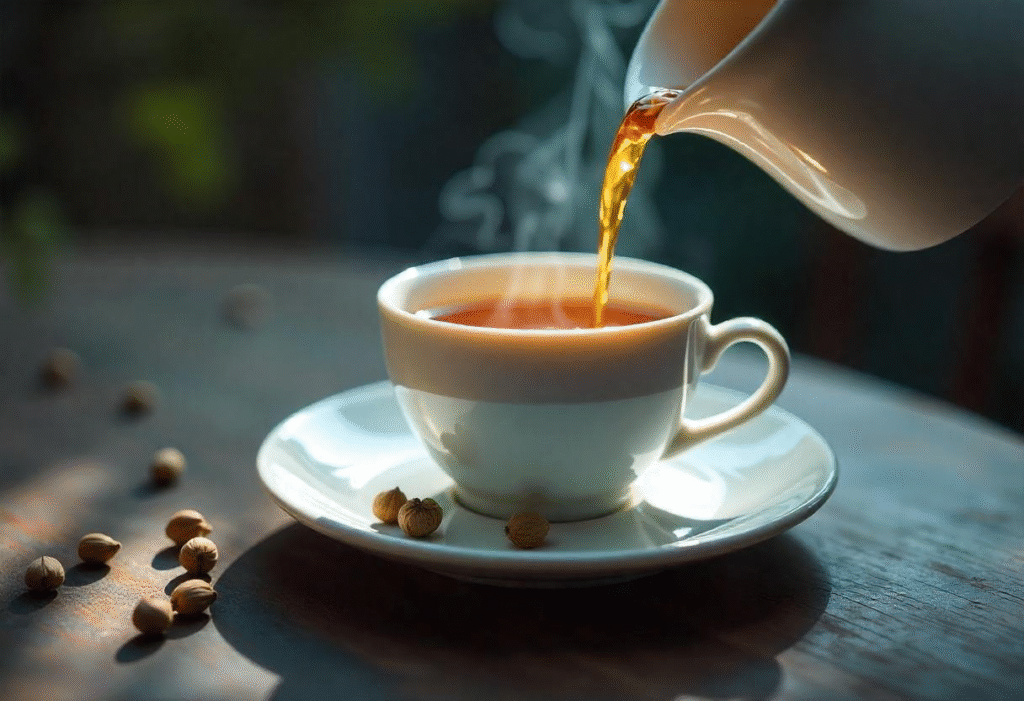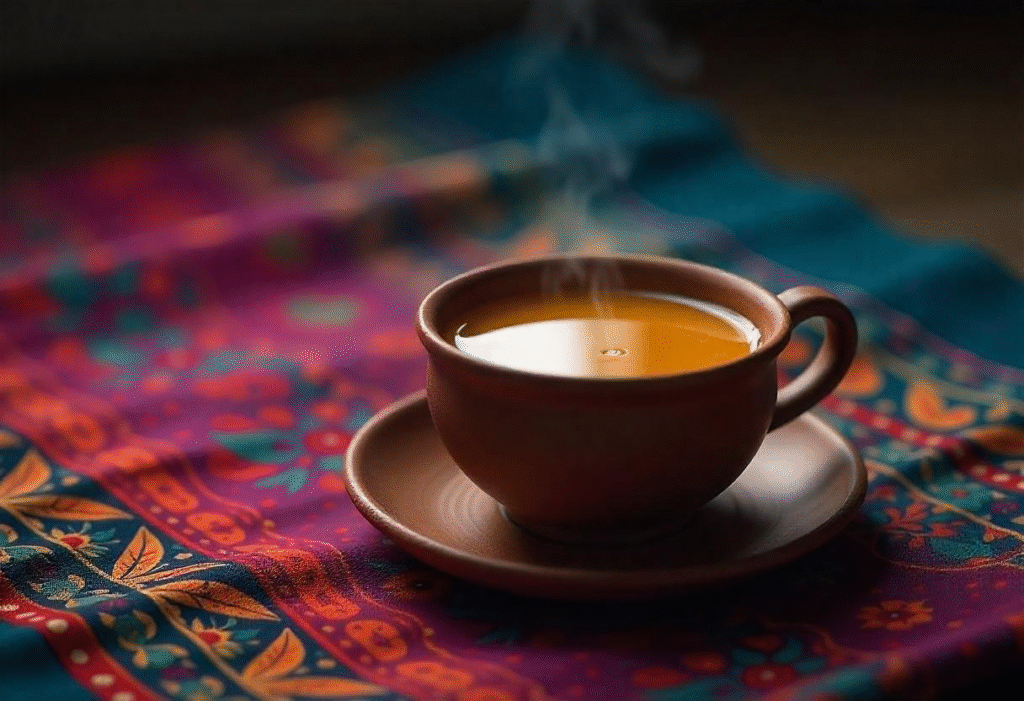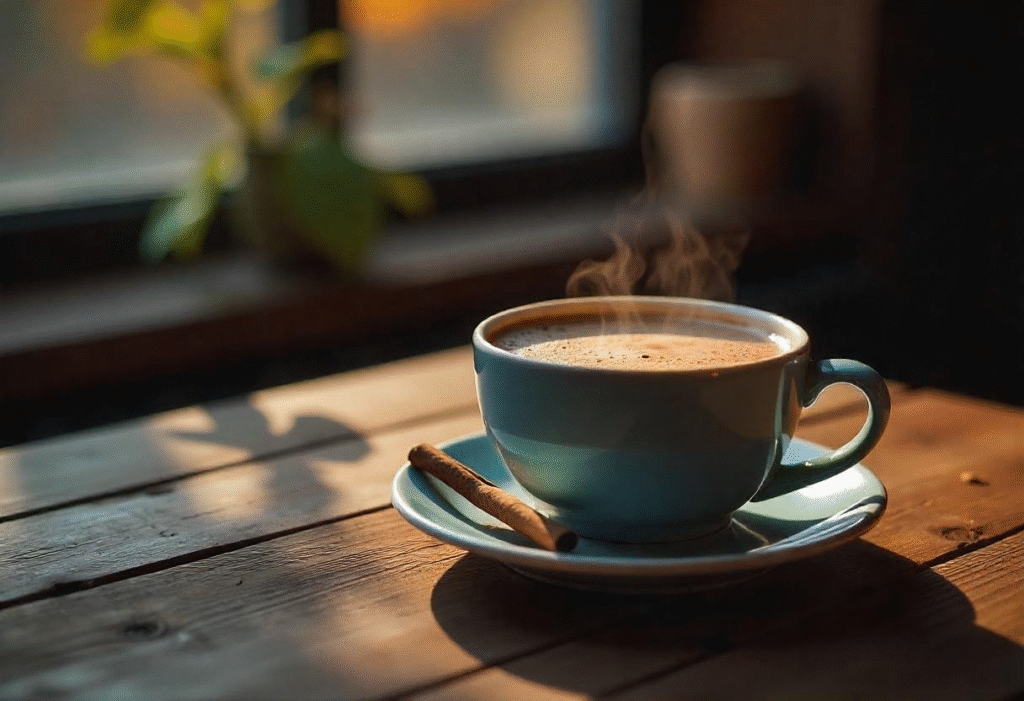Introduction: Why Homemade Chai Tea Is Worth the Effort
Chai tea has left its mark; in yoga studios, travel places, coffee shops, and the exotic spice marketplaces, people have fallen in love with the smell of the tea, the warming nature of the spices, and the comforting effect of a cup of tea. However, chai is just found in restaurants and stores, but it can never be as good, fresh, and sweet as the homemade chai tea blend.

Masala chai (literally meaning spiced tea) was an Indian creation, and it was not an all-purpose masala recipe. In fact, each area has variation, including every household. That is the gospel of chai; it is personal and variable and extremely gratifying.
So why make chai tea at home?
- Quality components: The quality of the tea and spices, as well as that of the sweeteners, is selected by you.
- Special taste: One can taste cardamom, ginger, cinnamon, or pepper more or less, according to taste.
- Fresh: The aromatic oil that fresh chai mix would have would be delicious, in comparison with a pre-packaged mix, which would be whole spices freshly ground.
- Better for health: it is healthier to avoid artificial flavoring and a lot of sugar in store-bought variants of syrup or chai in a container of powder.
- Ritual and comfort: Brewing chai is rather meditative, as well as de-stressing, and is one of the activities involving self-care.
And in our guide, we will demonstrate how you can make your very own mix of chai tea, and just as chai tea has become a special drink that has become the popular drink of choice nowadays, that same thing could happen to yours as well. You prefer strong peppery chai or sweet creamy chai; either way, you will be taught to make any combination, and it will be as unique as your morning routine.
What Is Chai Tea? Origins, Culture & Core Ingredients
Even though chai tea is a hot drink distributed in any cafes, it has a rich culture behind it, which is way beyond lattes and cool lists of food. Chai is simply tea in the Hindi language. Therefore, when an individual calls something chai tea, he or she is actually calling tea tea. The term, however, has gained a foothold in Western civilization, and it is generally understood to refer to the spiced Indian tea also known as the masala chai.
A Brief History of Chai
More than a thousand years ago, chai was invented in India, and it was nothing but an Ayurvedic drink as it was developed using healing herbs and creamy spices like ginger, cardamom, and cloves. When the British colonial power began exercising its influence and introducing the British black tea of Assam, the drink thus turned into a robust, milky, spiced elixir, which has now become a staple of an Indian household as well as of the Indian street sellers.
Fast forward to the present time, and chai is most definitely a global phenomenon that even appears in everything, such as cafes and candles. Nevertheless, if you have actually never tried to drink anything other than a powdered or sugary chai latte, then you have not yet reached its potential.
Core Ingredients of Chai Tea
An excellent chai tea will include:
- Black tea: Strong drinks and malty drinks, such as black tea, are best
- Whole seeds: newly ground cardamom, cinnamon, clove, ginger, and black pepper
- Sweetening agent: Sugar or honey is normally used
- Non-dairy / milk: To adjust the spice and give richness
Chai manufactured at home is very personal. The people who love ginger and seek Halloween, on the other hand, are cardamom lovers. Others are done using jaggery or condensed milk. It is the magic of chai in which the person adjusts to the drink.
The Perfect Chai Tea Blend: What You’ll Need
When creating your personal mix of chai tea, what you need to do is make a choice as to the type of tea to be used, the spices, and the sweeteners that you should include. All right, we will divide it into parts.
Best Black Tea Options
What’s in your drink must be powerful–strong enough to stand out against the media-billed spices. They are very good choices:
- Assam: malty, robust, and in line with good masala chai
- Darjeeling: Light and flowery, lighter black variety to compose more fragile mixtures
- Ceylon: heavy, smooth, well-fined tea
- Decaf Black Tea– It is your ideal drink when you are just in the mood for the flavor but not the caffeine.
Pro Tip: Do not use tealeaves that are susceptible to spoilage, like the green or white kinds, since they are eaten up by the spices.
Essential Chai Spices
These are the main spices that can be found in almost any recipe of an authentic chai tea:
- Cardamom (in pod or powder form): Floral, sweet, and the spirit of chai
- Clove: Gives richness and warmth
- Cinnamon (sticks or ground): Benevolent, sweet-spicy
- Ginger (dried or fresh): Serves to provide heat as well as digestive properties
- Black Pepper: Pungent, spic, and harmonizing
Optional Add-Ins for a Signature Twist
Feel like you want to personalize your chai? Add to this one or more of these:
- Star Anise: It has a licorice note
- Fennel Seeds: sugary and spiced
- Nutmeg: A comfort Christmas supplement
- Vanilla Bean or Extract Powder: Provides a creamy dessert-like touch. Evaporated Milk: “Whips” and fills up the body
Sweetener Choices
Indian Chai is sweet! Select depending on what you like or do not like to eat:
- Honey: floral and smooth
- Brown Sugar: Rich molasses-like flavor
- Coconut Sugar: Delicate and low-glycemic
- Stevia or Monk Fruit: zero-calorie natural alternatives
Tip: You can use a dry mix; just keep the sweeteners aside to allow the recipient to personalize.
Milk or Cream Alternatives
Chai is most appropriate when used in the creamy form. These are excellent recommendations:
- Whole Milk: The original base
- Oat Milk: Thick and sweet in nature
- Almond Milk: Nutty and light
- Coconut Milk: Cocky and tiki
- Sweetened Condensed Milk: This is a dessert-type version of milk applied in certain Southeast Asian kinds of chai
Barista types of non-dairy milks are best used for froth and lattes.
How to Make Your Own Chai Tea Mix (Dry & Concentrate)

Or you can have two general paths: the dry blend of chai tea that may take some time before the desired length of storage and gift-giving level, and the concentrate chai tea to have an easy-to-prepare latte whenever you want.
Dry Chai Mix (Great for Storage or Gifting)
Make a spice-and-tea mix that can keep for up to weeks.
How to make it:
- In order to use up whole spices, lightly crush them (with a mortar and pestle or spice grinder ).
- Cohar with loose black tea, tea bags.
- Keep in a glass jar that is airtight in a dry and cool place.
- Usage: To each cup (a to one ratio) of hot water (and milk), steep 1 tbsp of the powder. Simmer to achieve absolute flavor.
Perfect for: As a holiday gift, party favor, or pantry commodity.
Chai Tea Concentrate (For Quick Brewing & Lattes)
Prepare a chai liquid base that you can even keep in the refrigerator up to a week.
How to make it:
- Put some water into the pans and boil with crushed spices for 10-15 minutes.
- Stir in black tea, steep 5 to 7 minutes, and strain.
- Add sweetener to taste by stirring.
- Chill and refrigerate.
- Usage: 1 part concentrate +1 part milk. Can be served warm or cooled down.
Optional: Add a drop of vanilla or a dosage of salt in order to have more sweetness.
Spice Grinding & Storage Tips
- Whole spices: It is more flavourful and have a long shelf life
- You should only grind what is going to be used during 1-2 weeks
- Liquid concentrate: Refrigerate, use in up to 7-10 days.
- Wholesome spices: These are more durable, and they will not lose their flavor, as compared with powdered spices.
Bonus: It is also necessary to date and ingredient-label your mix, especially when you send it as a gift.
Brewing Chai Like a Pro: Hot, Iced, and Latte Styles
When you have prepared your homemade chai tea mix, it is time to brew like a master. No matter whether you prefer a hot and warm cup of coffee or a cool summer drink, the taste and the texture can be different due to the brewing process.
Traditional Stovetop Simmering Method
It is the traditional method to prepare Indian-style chai.
Steps:
- One cup of water + 1 cup of milk to a saucepan, add.
- Add 1 tbsp chai mix (instant or fresh mix).
- Simmer over low heat, 7 10 minutes, to mingle flavors.
- Press the zoom into a mug and sweeten to taste.
Pro Tip: The more you simmer, the greater the taste. Be careful not to boil hard.
Quick-Brew Method Using Chai Tea Concentrate
An ideal product to have on a busy morning or to make several cups.
Steps:
- Combine 12 cups of chai concentrate and 12 cups of milk (hot or cold).
- Warm in a bowl of hot water, or over ice to cool.
- Stir, and it is ready,–no straining required.
Great for: Prepping your office, prepping your meals, or giving a gift to your friends of a ready product.
Iced Chai Tea for Summer Sipping
Chilled, creamy, and spicy- just right when it is warm outside.
Steps:
- Make double-strength brew chai (dry mix or concentrate).
- Let stand or chill.
- Pour into a glass of ice water.
- Put milk or a milk-free substitute and a sweetener.
Optional: Cold foam, vanilla syrup, or a sprinkle of cinnamon may be added as a topping.
Frothy Chai Lattes at Home
Dress up your chai and transform it into a barista latte.
How to do it:
- Warm up and froth your milk with a milk frother, a French press, or a whisk.
- Pour foamed milk on hot chai.
- Put cinnamon or nutmeg on top.
Dairy-free tip: Oat milk and barista blends foam beautifully and add creaminess.
Iced Tea Mix Tips: How to Brew the Perfect Refreshing Blend Every Time
Flavor Twists to Make Your Chai Tea Unique
The biggest advantage of homemade chai? It is not a case of being left with the bare necessities. These are innovative twists of flavour to enable you to make your chai according to your mood, the season, or your urges.
Vanilla Chai, Chocolate Chai, or Golden Turmeric Chai
- Vanilla Chai: Refer to the dry mix and add a few drops of the pure vanilla extract or vanilla extract powder.
- Chocolate Chai: Put chunks of cacao nibs or cocoa powder to bring in that mocha effect.
- Turmeric Chai (Golden Chai): To get the anti-inflammatory properties and a golden color, add a pinch or two of ground turmeric and black pepper.
Pumpkin Spice Chai (Fall Favorite!)
This is a perfect autumn mix, and it contains:
- Cinnamon, nutmeg, ginger, clove, and allspice
- Optional: Pumpkin puree added to brews during the brewing process
- A coffee house-style topper would be whipped cream and pumpkin pie spice
Caffeine-Free Chai
Want chai without the buzz?
Use herbal bases like:
- Rooibos: Dusty, slightly sweet, and complemented by sweet spices
- Chamomile: To relax at bedtime, chai
- Honeybush: mild fruit-flavored caffeine-free substitute
Excellent during evening sipping or those blends that are family-friendly.
Exotic & Floral Variations
- Coconut Chai: Cook with dried coconut flakes or add coconut milk to make it tropical
- Rose Chai: Add dried rose petals to have the fragrance and a look of flowers
- Extra-Spicy Masala Chai: Add more black pepper, ginger, and cloves to taste the bold flavour
Play with balance- begin with a pinch of your favorite twist and go on.
Gifting & Storing Your Homemade Chai Tea Mix
Chai tea is a beautiful and considerate present anytime of the year. It smells good, packs nicely, and is a great gift to tea drinkers, health junkies, or homebodies.
How to Package Chai Tea as a Gift
- Mason Jars: Visual information layering 2) tea and spices
- Spice tubes: Slimline, streamlined, modern, they are ideal for sampler sets, too.
- Glass Bottles: These bottles are wonderful for chai concentrate
- Muslin Bags or Sachets: environmentally friendly and steeping ready
Add a tag that includes steeping directions and whatever you want to call your custom blend (e.g., Spiced Serenity Blend or Winter Hug Chai).
Personalize Your Chai Blend
Make it memorable:
- Build your own label and label a name of your own
- Put a list of ingredients in the given order
- Include a message or a best-by date
Great for: Birthdays, holidays, wedding favors, or self-care boxes
Storage Tips
- Dry chai mix: Sit in a dry place not exposed to light or water, and it lasts up to 6 months.
- Liquid concentrate: Store in the refrigerator, consume within 7-10 days
- Entire spices: They are longer-lasting and do not lose flavor in comparison to ground spices.
It is always important to label your mix with dates and ingredients, particularly when you are giving it as a gift.
Common Mistakes to Avoid When Making Chai Tea

These are the mistakes even experienced chai drinkers commit; you should not do these, and then you can have the best taste and experience.
- Overpowering Spices
- Excessive amounts of clove or pepper in your chai will ruin the taste because it will become bitter or so pungent. Light and progress in adjustment.
- Using Stale Spices or Weak Tea
- Excessive spices go out of flavor and effect. Fresh, aromatic ingredients should always be used. Major spices cannot be used with weak tea.
- Not Simmering Long Enough
- Chai requires time. A hurried process will create a ho-hum taste that is flat-flavored. Allow your spices to steep.
- Over-Sweetening or Under-Mixing
- An overdose of sugar may cloud your judgment. When pouring as well, make sure you thoroughly stir your concentrate as it may settle with time.
Conclusion: Your Perfect Chai Starts Here
Chai tea mixture is simple to make at home, extremely delicious, and satisfying. Based on the assortment of tea, spices, and milk, an individual can make a cup of tea, which will most effectively satisfy their taste, whether it is hot, iced, or a latte. It is time to experiment and make chai your new favorite practice.
Explore More Details – Click to Learn!
FAQs About Chai Tea
Is it possible to have non-caffeine chai tea?
Yes! Rooibos, honeybush, or herbal teas can be used as a substitute for a black tea base, in place of caffeine.
What is the expiration date of the homemade chai tea mix?
Dry mixes have a life of 6 months. The shelf life of Liquid Wort in the fridge is 7-10 days.
Which is the best milk to use in a chai latte?
Any whole milk is classic, and the processes of oat, almond, or coconut milk are fantastic, non-dairy alternatives that can be frothy.





